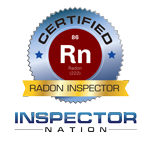Gas heaters designed to be vent-free use the air in the home for combustion. In order to safely do this without depleting the oxygen in the home they are designed to burn very efficiently and they have an Oxygen Depletion Sensor installed that shuts the system down when oxygen levels drop too low. This vent-free design is appealing because the homeowner has more options as to where the heater can be installed. However, they are not intended to be the main source of heat in the home. Instead they are considered to be supplemental heating units to be used in conjunction with a central HVAC system that keeps the air circulating in the home.

My Job:
My job during an inspection is to inspect and operate all built-in heating units, which includes vent-free gas fired heaters. The defects I am looking for are more related to safety concerns. The installation details and the visible condition of the unit tell me a great deal about how safe the unit is. The following are details and defects I am on the search for when inspecting vent-free gas heaters:
Location: Vent-free gas heaters are not supposed to be installed in bathrooms or bedrooms. The only gas heaters that can be installed in these areas are those that receive their combustion air from the outside and vent their exhaust outside, or those specifically designed for a bedroom or bathroom.

Condition: No gas heater should produce soot. Anytime there is soot build up on a heating unit it is an indication of improper combustion. Soot can result from clogged burner ports or logs that have been installed in the wrong position or are damaged and are blocking the flame path.

Alarms: Anytime a gas heater or appliance is installed in a home, the homeowner should have a carbon monoxide detector installed. Carbon Monoxide is odorless and tasteless by product that can cause serious physical harm, so it is extremely important to have an alarm nearby that helps alert you when the oxygen levels are getting too low.

Gas Shut Off: A gas shut off is a valve that should be installed on the gas line in order to allow the homeowner and service professionals to shut the gas off in the event of a safety hazard or when needing to service the unit. The gas shut off should be installed within six feet of the unit and in the same room of the unit. It is not best practice for this shut off to be installed inside the firebox because it needs to be safely accessible.

Caution: As I said at the beginning of this article, vent-free gas heaters are not intended to be used as primary sources of heat for long periods of time. One reason is because even the tiny amount of combustion products the units release inside the home can have some negative effects on one’s physical health. Also, because the units release moisture in the air, when operated for long periods of time, they can create an environment in the home that is conducive to condensation and mold. A house is more at risk of these concerns, the more tight it has been built. For these reasons, it is best to use these units for a short amount of time and to crack a window to allow for some oxygen replacement.
Conclusion:
Vent-free gas heaters are very appealing to homeowners and can be enjoyable sources of supplemental heat. You just need to remember to have the unit inspected, maintenanced, and serviced regularly to ensure it is operating within the manufacturers specifications, provide adequate fresh air when it is in use, and have a carbon monoxide detector installed. If you have concerns about your fireplace, it would be my pleasure to provide you with an inspection of your unit to ensure it is safe and functioning properly. When you really want to know, contact Adam Duncan of Duncan Home Inspection Services, LLC.






 >
>